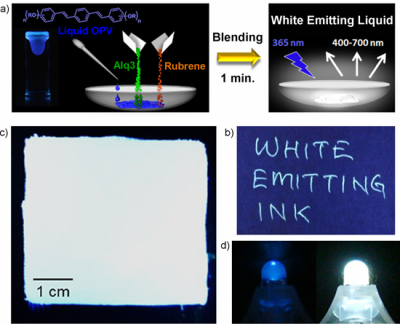Directed by Dr. Takashi Nakanishi of NIMS Polymer Materials Unit, a team of researchers developed a nonvolatile liquid material that generates white light at room temperature.

National Institute for Materials Science
Innovative materials and technological advancements will lead to minimal emissions of greenhouse effect gases (GHG) as lighting devices enable 20% of all electric power utilization. While organic materials dispersed in a solution exhibit a white light-emitting property, the molecules will aggregate when solution is coated on a substrate followed by evaporation of solvent. This property controls the emission of intrinsic white-light. An organic material created free of volatile organic solvents delivers homogeneous, high brightness white light-emission.
This research team formulated a liquid material that includes nonvolatile blue light fluorescence having -45°C melting point. By altering highly flexible branched alkyl chains around the fluorescence-emitting molecule, molecule aggregation, can be controlled. This liquid material has room temperature viscosity with 1.0 Pa•s, without the need for a volatile organic solvent. A blue light emission is displayed including 50% of absolute fluorescent quantum yield. Mixing luminescent dyes to the solid powder in liquid, results in white light-emitting paste material. This led to the preparation of white light-emitting lights by coating on a UV-LED surface, printing of white light-emitting characters, large area coating and many more.
By mixing small quantities of solid dyes in the nonvolatile, blue light-emitting liquid, high quality white-light emitting materials can be created. This is followed by coating the liquid material onto substrate surfaces of different shapes, giving rise to simpler production process for lighting devices and other products. High brightness control of emitted color leads to the production of liquids that display full-color light emission, which will be of much use in next-generation printable electronics.
Disclaimer: The views expressed here are those of the author expressed in their private capacity and do not necessarily represent the views of AZoM.com Limited T/A AZoNetwork the owner and operator of this website. This disclaimer forms part of the Terms and conditions of use of this website.